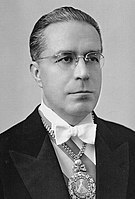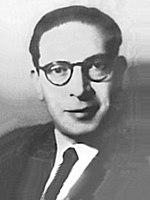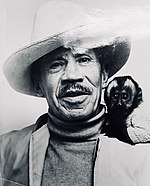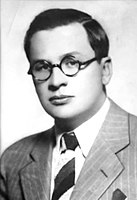Cabinet of Gualberto Villarroel
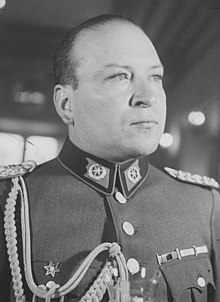 | |
| Presidency of Gualberto Villarroel 20 December 1943 – 21 July 1946 | |
| Party | RADEPA |
|---|---|
| Seat | Palacio Quemado |
|
| |
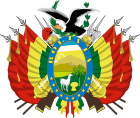 |
|---|
|
|



Gualberto Villarroel assumed office as the 39th President of Bolivia on 20 December 1943, and his term was violently cut short on 21 July 1946. A Colonel during the Chaco War, Villarroel and the Fatherland's Cause (RADEPA) joined the fledgling Revolutionary Nationalist Movement (MNR) to overthrow President Enrique Peñaranda in a coup d'état.
Villarroel's first cabinet was formed on 20 December 1943. Due to various controversies surrounding public and international perception of the MNR, which at the time was erroneously believed to have pro-Nazi sympathies, Villarroel would form a total of four ministerial cabinets constituting the 108th to 111th national cabinets of Bolivia. A fifth cabinet was announced on 20 July 1946 but the events of 21 July which resulted in the deposition of the government halted that cabinet from entering office.
Cabinet Ministers
Cabinet of Bolivia Presidency of Gualberto Villarroel, 1943–1946 | |||||||
|---|---|---|---|---|---|---|---|
| Office | Name | Party | Term | Prof. | N.C[a] | P.C[b] | |
| President | Gualberto Villarroel | RADEPA | 20 December 1943 – 21 July 1943 | Mil. | – | – | |
| Vice President | Office blank 20 December 1943 – 24 November 1945[c] | ||||||
| Julián Montellano | style="background:Template:Revolutionary Nationalist Movement/meta/color;" | | MNR | 6 November 1945 – 21 July 1943 | Law. | – | – | |
| Minister of Foreign Affairs and Worship (Chancellor) |
José Tamayo Solares[1] | style="background:Template:United Socialist Party (Bolivia)/meta/color;" | | PSI | 20 December 1943 – 16 March 1944 | Law. | 108 | 1 |
| Enrique Baldivieso | style="background:Template:United Socialist Party (Bolivia)/meta/color;" | | PSI | 16 March 1944 – 8 August 1944 | Law. | 109 | 2 | |
| Víctor Andrade Uzquiano | rowspan="1" style="background:Template:Revolutionary Nationalist Movement/meta/color;" | | Ind. | 8 August – 31 December 1944 | Law. | 110 | 3 | |
| Gustavo Chacón[d] | style="background:Template:Independent politician/meta/color;" | | Ind. | 31 December 1944 – 21 July 1944 | – | 111 | 4 | |
| Minister of Finance and Statistics | Víctor Paz Estenssoro | rowspan="1" style="background:Template:Revolutionary Nationalist Movement/meta/color;" | | MNR | 20 December 1943 – 5 April 1944 | Law. | 108 | 1 |
| Jorge Zarco Kramer | rowspan="1" style="background:Template:Independent politician/meta/color;" | | N/A | 5 April 1944 – 31 December 1944 | Law. | 109 | 2 | |
| Víctor Paz Estenssoro | rowspan="1" style="background:Template:Revolutionary Nationalist Movement/meta/color;" | | MNR | 31 December 1944 – 21 July 1944 | Law. | 111 | 4 | |
| Minister of Government, Justice,
and Immigration |
Alberto Taborga[2] | RADEPA | 20 December 1943 – 11 February 1944 | Mil. | 108 | 1 | |
| Alfredo Pacheco | RADEPA | 11 February 1944 – 8 August 1944 | Mil. | 108 | 1 | ||
| Alfonso Quinteros | RADEPA | 8 August – 31 December 1944 | Mil. | 110 | 3 | ||
| Edmundo Nogales Ortiz | RADEPA | 31 December 1944 – 21 July 1946 | Mil. | 111 | 4 | ||
| Minister of National Defense | José Celestino Pinto[e] | RADEPA | 20 December 1943 – 21 July 1946 | Mil. | 108 | 1 | |
| Ángel Rodríguez | RADEPA | 21 July 1946 – 21 July 1946 | Mil. | – | 5 | ||
| Minister of Economy | Gustavo Chacón | style="background:Template:Independent politician/meta/color;" | | Ind. | 20 December 1943 – 31 December 1944 | – | 108 | 1 |
| Minister of Agriculture, Livestock,
and Colonization |
Carlos Montenegro | style="background:Template:Revolutionary Nationalist Movement/meta/color;" | | MNR | 20 December 1943 – 11 February 1944 | Law. | 108 | 1 |
| Rafael Otazo | style="background:Template:Revolutionary Nationalist Movement/meta/color;" | | MNR | 11 February 1944 – 5 April 1944 | – | 108 | 1 | |
| Edmundo Nogales Ortiz | RADEPA | 5 April 1944 – 31 December 1944 | Mil. | 109 | 2 | ||
| Julio Zuazo Cuenca | style="background:Template:Revolutionary Nationalist Movement/meta/color;" | | MNR | 31 December 1944 – 21 July 1944 | – | 111 | 4 | |
| Minister of Public Works and Communications | Antonio Ponce | RADEPA | 20 December 1943 – 21 July 1946 | Mil. | 108 | 1 | |
| Minister of Work, Hygiene, and Social Security |
Víctor Andrade Uzquiano | rowspan="1" style="background:Template:Revolutionary Nationalist Movement/meta/color;" | | Ind. | 20 December 1943 – 8 August 1944 | Law. | 108 | 1 |
| Remberto Capriles | rowspan="2" style="background:Template:Independent politician/meta/color;" | | N/A | 8 August – 31 December 1944 | – | 110 | 3 | |
| Minister of Work, Health, and Social Security | |||||||
| Germán Monroy Block | style="background:Template:Revolutionary Nationalist Movement/meta/color;" | | MNR | 31 December 1944 – 21 July 1944 | Law. | 111 | 4 | |
| Minister of Education, Fine Arts,
and Indigenous Affairs |
Jorge Calero[f] | RADEPA | 20 December 1943 – 21 July 1946 | Mil. | 108 | 1 | |
| Secretary General of the Junta | Augusto Céspedes Patzi | rowspan="1" style="background:Template:Revolutionary Nationalist Movement/meta/color;" | | MNR | 20 December 1943 – 11 February 1944 | Jrnl. | 108 | 1 |
| Wálter Guevara | rowspan="1" style="background:Template:Revolutionary Nationalist Movement/meta/color;" | | MNR | 11 February 1944 – 5 April 1944 | Law. | 108 | 1 | |
| Command transmitted to Gualberto Villarroel on 5 April 1944 | |||||||
Composition
First cabinet
On 20 December 1943, members of the RADEPA young officers clique, in conjunction with MNR militants, overthrew the conservative government of President Enrique Peñaranda. A military junta was subsequently formed which comprised the first Villarroel ministerial cabinet. The junta was a mixture of military officers led by Colonel Gulaberto Villarroel as de facto President of the Republic and MNR politicians led by Minister of Finance Víctor Paz Estenssoro with Augusto Céspedes Patzi as Secretary General.[5]
The new government faced opposition and lack of recognition from the United States.[6] The distrust came as a result of U.S. participation in World War II and the erroneous belief (sparked by President Peñaranda in order to persecute political opponents)[7] that the MNR was pro-Nazi and pro-Axis. Attempts to placate the U.S. led to the removal of top MNR ministers Augusto Céspedes and Carlos Montenegro, as well as Alberto Taborga on 11 February 1944 but the U.S. maintained its rigid stance so long as the MNR remained in government.[8]
Second cabinet
Ultimately, the Villarroel government acquiesced and all remaining MNR ministers, including Paz Estenssoro, were removed on 5 April 1944. The removal of Wálter Guevara, who had succeeded Céspedes as Secretary General of the Junta, brought an end to the military junta and the first Villarroel cabinet.[9] The second Villarroel cabinet was subsequently formed with "no MNR official in any position of prominence in Bolivia." This finally resulted in the U.S. recognizing the Villarroel regime in May 1944.[10]

Third and fourth cabinets
A third ministerial cabinet was formed upon the resignation of three senior ministers on 8 August 1944.[11] On 31 December 1944, with U.S.-Bolivia tensions cooled, the Villarroel administration once again invited the MNR into ministerial positions, with Paz Estenssoro returning to his position as Finance Minister. Thus was formed the fourth Villarroel cabinet. At 567 days, this was the longest lasting cabinet of the Villarroel presidency.
1945 saw the return of the office of the Vice Presidency. The position had been abolished by the government of Carlos Quintanilla on 4 December 1939 but was readded with the promulgation of the new Political Constitution of 24 November 1945.[12][13] By that point, Julián Montellano of the MNR had already been proclaimed Vice President on 3 November and inaugurated on 6 November.[14] Though the office would be vacant during long periods of time from the 1960s to the 1980s, it would never again be abolished.
By July 1946, Villarroel's government had lost its popularity due to the harsh repressions of the opposition and voices critical of the government. These tensions peaked when a tripartite group of workers, students, and teachers threatened to strike if wages were not raised and the MNR stayed in government.[15] The situation spiralled out of control when the MNR Minister of Agriculture Julio Zuazo Cuenca was among a group of government officials who drunkenly smashed the windows of the Higher University of San Andrés. Attempting to deescalate the situation, President Villarroel demanded the resignation of Zuazo on 19 July. Eventually, a fifth all-military cabinet was announced on 20 July without a single holdover from the previous cabinet which presented its resignation at 7 p.m.[15][16] General Ángel Rodríguez was named Minister of Defense, announcing a halt on the military's order to fire on protesters. Despite these efforts, the new cabinet would never take office as President Villarroel would be overthrown and lynched the following day, bringing an end to his government.
Analysis
The administration of Gualberto Villarroel saw the definitive end of Military Socialism leading government. The concept, conceived by President David Toro, and brought about by President Germán Busch had been an inspiration for the policies of RADEPA and Villarroel. Villarroel's cabinets would feature several ministers who would go on to become influential political figures in the MNR, not least of which being Finance Minister Víctor Paz Estenssoro who would go on to win the presidency a total of four times in 1951, 1960, 1962, and 1985. His party, the MNR, and its splinter groups would dominate Bolivian democratic politics from the 1952 National Revolution up until its fall from grace in 2003. Other MNR ministers in the Villarroel cabinet included Wálter Guevara, a distinguished statesman and diplomat who would serve as interim president in 1979, and Augusto Céspedes, a notable writer, journalist, and diplomat.
Gallery
-
Julián Montellano – Vice President (MNR)
-
Enrique Baldivieso – Chancellor (PSI)
-
José Celestino Pinto – Minister of Defense (RADEPA)
-
Augusto Céspedes Patzi – Secretary General of the Junta (MNR)
-
Carlos Montenegro - Minister of Agriculture (MNR)
-
Jorge Calero - Minister of Education (RADEPA)
Notes
- ^ Denoting whether the minister was a member of the 108th, 109th, 110th, or 111th national cabinet of Bolivia
- ^ Denoting whether the minister was a member of the president's first, second, third, or fourth cabinet
- ^ On 3 November 1945, Julián Montellano would be proclaimed Vice President of the Republic and inaugurated on 6 November. However, the office of Vice President would remain officially abolished until the promulgation of a new constitution on 24 November.
- ^ The remainder of Chacón's term starting on 19 October 1945 would be fulfilled by José Celestino Pinto and later Jorge Calero
- ^ Simultaneously Interim Foreign Minister from 19 October 1945 to 27 May 1946[3]
- ^ Simultaneously Interim Foreign Minister from 27 May 1946 to 21 July 1946[4]
References
- ^ "canciller". web.archive.org. 2 February 2016. Retrieved 24 January 2021.
- ^ Lora, Guillermo. "Diccionario Politico, Historico, Cultural (T)" (PDF).
{{cite journal}}: Cite journal requires|journal=(help) - ^ "canciller". web.archive.org. 3 January 2016. Retrieved 24 January 2021.
- ^ "canciller". web.archive.org. 3 January 2016. Retrieved 24 January 2021.
- ^ "Bolivia: Decreto Ley de 20 de noviembre de 1943". www.lexivox.org. Retrieved 24 January 2021.
- ^ Blasier, pp. 42
- ^ Blasier, pp. 39
- ^ "DECRETO LEY No 42 del 11 de Febrero de 1944 » Derechoteca.com". www.derechoteca.com. Retrieved 24 January 2021.
- ^ "DECRETO LEY No 84 del 05 de Abril de 1944 » Derechoteca.com". www.derechoteca.com. Retrieved 24 January 2021.
- ^ Blasier, pp. 43
- ^ "DECRETO LEY No 177 del 08 de Agosto de 1944 » Derechoteca.com". www.derechoteca.com. Retrieved 24 January 2021.
- ^ "Bolivia: Decreto Ley de 4 de diciembre de 1939". www.lexivox.org. Retrieved 24 January 2021.
- ^ "Bolivia: Constitución política de 1945, 24 de noviembre de 1945". www.lexivox.org. Retrieved 24 January 2021.
- ^ "Bolivia: Ley de 3 de noviembre de 1945". www.lexivox.org. Retrieved 24 January 2021.
- ^ a b Fulgor.com, El (19 July 2020). "Las últimas horas del Gobierno de Gualberto Villarroel". El Fulgor (in Spanish). Retrieved 28 November 2020.
- ^ Flack, Joseph (21 July 1946). "Diary of a Successful Revolution" (PDF). The American Foreign Service Journal: 22–26.
{{cite journal}}: Check|first=value (help)
Bibliography
- Gisbert, Carlos D. Mesa (2003). Presidentes de Bolivia: entre urnas y fusiles : el poder ejecutivo, los ministros de estado (in Spanish). Editorial Gisbert. pp. 346–347.
- Blasier, Cole. The United States, Germany, and the Bolivian Revolutionaries (1941-1946).

